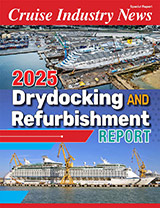Costa Cruises officially kicks off the works for “Palazzo Costa”, an innovative architectural project for expanding and restyling the company’s headquarters in Genoa.
The new Palazzo, that will change the look of one of the city’s most famous squares, will be the perfect combination of research, innovation and respect for the environment, and present some truly avant-garde features as far as Italy’s architectural sector is concerned. In fact, it will be one of the first Italian buildings with “0 onsite emissions” of carbon monoxide and one of the first to use a futuristic large-slab glass roof covering an area of 1,500 m² specially designed for this project. Another salient feature of the project is a covered square, on the third floor, where a sculpture created specifically for Costa Cruises by the artist-designer Jacopo Foggini will be exhibited along with works of art from Costa’s private collection: sculptures, tapestries and panels from the fleet’s ships. Other distinctive characteristics of the terraces will be the skilful use of greenery, to create hanging gardens, and an external wall embellished by graffiti by a group of Spanish artists, where a waterfall plunges into a huge pool on the Torre San Camillo terrace. A truly innovative and environmentally-friendly project for a company that makes design a real communication tool. The project will be branded by the large “C” of the Costa logo – consisting of more than 7,000 LEDs created by the Genoa-based Finetti – that will stand out from the top of the glass roof, a striking revolving sign, similar to a lighthouse, to illuminate the evenings and nights.
“The new building puts the spotlight on Costa Cruises’ roots in Genoa and is proof of the intense development that our company is currently undergoing” – stated Fabrizia Greppi, Costa Cruises V.P. Corporate Communication. “The project that we selected to create the Palazzo is inspired by the cornerstones of our company philosophy and our brand: innovation, design, employee well-being and protection plus environmental protection”.
“For the city administration – declared Mario Margini, Genoa’s city councilman for Labour Policies – commencing the project to expand Costa Cruises’ headquarters in Genoa is considered an important sign to bolster cruise activities in our city. Costa Cruises, with consolidated management and technical services in Genoa, is an important and driving force behind the city’s economic operations. Dozens and dozens of young people have found qualified job opportunities in the cruise industry. The new headquarters is a sign of interest for our city that we consider quite positively and the civic administration is, as always, more than willing to interact with all those who intend on strengthening their production activities in Genoa”.
This major work plan calls for the restyling of the current “ex -Amiu” Palazzo in Piazza Piccapietra 43 – acquired by Costa Cruises – and its connection with the two spaces that the company already occupies in Torre San Camillo (Via XII Ottobre 2) and in the “ex Coin” area on Via XII Ottobre 4. This will increase the surface area of the headquarters to about 10,000 m², which then should be added to the 7,000 m² of office space and warehouses in the building on Via De Marini, for a total of more than 650 work stations in the two structures by December 2009, the project’s scheduled completion date.
The project’s supervisor and artistic director is the architect, Marcello Albini. Along with another architect, Emanuela Venturini, he designed the “C” dream, Costa Cruises’ innovative lounge bar that opened in 2004. The idea for the new “Palazzo Costa” that architects Albini and Venturini came up with in 2004 was a “natural extension” of the same “poetic” atmosphere that permeates the “C” dream. Starting in 2005 the project was developed by Albini, with support from a team of Italian designers (engineers and architects).
“The basic characteristic of this project is its simplicity – explains Albini – which means avoiding purely spectacular or extreme solutions and concentrating on the harmony of shapes, on the choice of materials and their finishes, and on compliance with safety standards and current criteria to create energy-saving systems. Another no less important factor is the context where the building is located. Just after the motorway exit Genoa welcomes us with its sea: the water, the transparency, the colour and the blue that become azure, turquoise, indigo; on one side the port, the new structures by Renzo Piano, the Sea Museum and, on the other, the old city intoned by De Andrè, along with Gino Paoli’s roofs and cats”.
This is the starting point from which Albini began to conceive of the building’s new and distinctive façade: once the project has been completed, what will be seen from Via XII Ottobre or while walking through Piazza Piccapietra will be in fact an entire building made of transparent glass, that will become different shades of blue, the colour of the sky and of the sea, thanks to the use of a LED lighting system. The hues will change as the light changes during the day, creating a special dynamic effect. The glass, a material with transparency, luminosity and lightness, basic concepts of the project’s philosophy, will be the main feature of the new building, and will cover more than 2,600 m². The first two floors of Palazzo Costa will be used to create different decorative “sails”, while the upper floors will be utilised to create a gigantic glass “display case” with large slabs. A special silk-screening process will allow those inside to see outside, creating the feeling of a single large block of ice.
This type of glass facing has been specially designed for the Palazzo project, based on some famous architectural designs in London, such as those in the Canary Wharf area, in Barcelona, like the Music Museum and in Salzburg, for the new airport hangar. Very high quality components are used, just like the plastic “film” used for the Skywalk Bridge over the Grand Canyon.
One of the most innovative aspects of Palazzo Costa is linked to respect for the environment. In fact, innovative plant engineering materials and techniques will be used to obtain the greatest energy savings and to reduce polluting emissions. In addition to installing new windows with high thermal and solar performance ratings and innovative heat pumps capable of recovering the heat generated by the cooling cycles, re-utilising it whenever required in the form of heating, the glass roof covering the building will act like an interspace to reduce the thermal range between the outdoor and indoor temperatures, making it less costly, in terms of energy savings, to maintain an optimum temperature during the summer and in the winter. The exclusive use of electrically-powered plants will make the building one of the first in Italy with “0 onsite emissions” of carbon monoxide. This will help to keep the city’s air clean and will lead to a final yield, in terms of consumption, of more than 140%. Identical measures were taken with regard to lighting, which will consist of special LEDs and low-energy lamps, and especially at night. Finally, the use of greenery on the terraces will enhance the structure’s thermal and acoustic insulation, have a positive effect on the climate in the various ambiences, and capture the dust and part of the rain water that otherwise would have to be eliminated.
An expert use of natural light and materials was also taken into consideration for the building’s interiors, where reflections in a balanced contrast with the dark finishes of the floors and the silver hues of the cabinet furniture and false-ceilings blend with a work environment that is suitable and fundamental for a company that has always focused on the well-being of its employees. Like the “C” dream, Palazzo Costa will also be embellished by furnishings created by great names of Italian design, like the sofas by Rossi d’Albizzate or the lamp by Italamp, personalised by Swarovski, the Gabetto resins and the decorator materials by P&G.
An exhibition area set up inside the company’s current location will allow Costa Cruises employees to keep track of how the works for the new Palazzo Costa are progressing.



